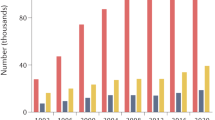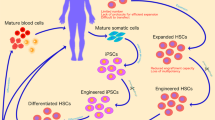Abstract
One major complication facing organ transplant recipients is the requirement for life-long systemic immunosuppression to prevent rejection, which is associated with an increased incidence of malignancy and susceptibility to opportunistic infections. Gene therapy has the potential to eliminate problems associated with immunosuppression by allowing the production of immunomodulatory proteins in the donor grafts resulting in local rather than systemic immunosuppression. Alternatively, gene therapy approaches could eliminate the requirement for general immunosuppression by allowing the induction of donor-specific tolerance. Gene therapy interventions may also be able to prevent graft damage owing to nonimmune-mediated graft loss or injury and prevent chronic rejection. This review will focus on recent progress in preventing transplant rejection by gene therapy.
This is a preview of subscription content, access via your institution
Access options
Subscribe to this journal
Receive 12 print issues and online access
$259.00 per year
only $21.58 per issue
Buy this article
- Purchase on Springer Link
- Instant access to full article PDF
Prices may be subject to local taxes which are calculated during checkout

Similar content being viewed by others
References
Sharpe AH and Freeman GJ . The B7-CD28 superfamily. Nat Rev Immunol 2002; 2: 116–126.
Guillot C et al. Gene therapy in transplantation in the year 2000: moving towards clinical applications? Gene Therapy 2000; 7: 14–19.
Guillot C et al. Tolerance to cardiac allografts via local and systemic mechanisms after adenovirus-mediated CTLA4Ig expression. J Immunol 2000; 164: 5258–5268.
Malm H et al. CTLA4ig induces long-term graft survival of allogeneic skin grafts and totally inhibits T-cell proliferation in LFA-1-deficient mice. Transplantation 2002; 73: 293–297.
Reddy B et al. The effect of CD28/B7 blockade on alloreactive T and B cells after liver cell transplantation. Transplantation 2001; 71: 801–811.
Comer RM et al. Effect of administration of CTLA4-Ig as protein or cDNA on corneal allograft survival. Invest Ophthalmol Vis Sci 2002; 43: 1095–1103.
Li TS et al. Prolonged survival of xenograft fetal cardiomyocytes by adenovirus-mediated CTLA4-Ig expression. Transplantation 2001; 72: 1983–1985.
Takehara M et al. Long-term acceptance of allografts by in vivo gene transfer of regulatable adenovirus vector containing CTLA4IgG and loxP. Hum Gene Ther 2001; 12: 415–426.
Nomura M et al. Induction of donor-specific tolerance by adenovirus-mediated CD40Ig gene therapy in rat liver transplantation. Transplantation 2002; 73: 1403–1410.
Guillot C et al. Prolonged blockade of CD40–CD40 ligand interactions by gene transfer of CD40Ig results in long-term heart allograft survival and donor-specific hyporesponsiveness, but does not prevent chronic rejection. J Immunol 2002; 168: 1600–1609.
Greenwald RJ et al. CTLA-4 regulates induction of anergy in vivo. Immunity 2001; 14: 145–155.
Coyle AJ, Gutierrez-Ramos JC . The expanding B7 superfamily: increasing complexity in costimulatory signals regulating T cell function. Nat Immunol 2001; 2: 203–209.
Ozkaynak E et al. Importance of ICOS-B7RP-1 costimulation in acute and chronic allograft rejection. Nat Immunol 2001; 2: 591–596.
Sykes M . Mixed chimerism and transplant tolerance. Immunity 2001; 14: 417–424.
Bagley J et al. Establishing immunological tolerance through the induction of molecular chimerism. Front Biosci 2002; 7: 1331–1337.
Sonntag KC et al. Tolerance to solid organ transplants through transfer of MHC class II genes. J Clin Invest 2001; 107: 65–71.
Heim DA et al. Introduction of a xenogeneic gene via hematopoietic stem cells leads to specific tolerance in a rhesus monkey model. Mol Therapy 2000; 1: 533–544.
Bagley J et al. Induction of T-cell tolerance to an MHC class I alloantigen by gene therapy. Blood 2002; 99: 4394–4399.
Kang ES, Iacomini J . Induction of central deletional T cell tolerance by gene therapy. J Immunol 2002; 169: 1930–1935.
Tian C, Bagley J, Iacomini J . Expression of antigen on mature lymphocytes is required to induce T cell tolerance by gene therapy. J Immunol 2002; 169: 3776.
Zelenika D et al. The role of CD4+ T-cellsubsets in determining transplantation rejection or tolerance. Immunol Rev 2001; 182: 164–179.
Waldmann H, Cobbold S . Regulating the immune response to transplants. A role for CD4+ regulatory cells? Immunity 2001; 14: 399–406.
Graca L et al. Both CD4(+)CD25(+) and CD4(+)CD25(−) regulatory cells mediate dominant transplantation tolerance. J Immunol 2002; 168: 5558–5565.
Fry JW, Morris PJ, Wood KJ . Adenoviral transfer of a single donor-specific MHC class I gene to recipient bone marrow cells can induce specific immunological unresponsiveness in vivo. Gene Therapy 2002; 9: 220–226.
Bracy JL, Iacomini J . Induction of B cell tolerance by retroviral gene therapy. Blood 2000; 96: 3008–3015.
Iacomini J, Bracy JL . Inducing tolerance by molecular chimerism. Graft 2001; 4: 102–104.
Bracy JL et al. Induction of molecular chimerism by gene therapy prevents antibody mediated heart transplant rejection. Gene Therapy 2001; 8: 1738–1744.
Cretin N et al. The role of T cell help in the production of antibodies specific for Gal alpha 1–3Gal. J Immunol 2002; 168: 1479–1483.
Bracy J, Iacomini J . Engraftment of genetically modified bone marrow cells in sensitized hosts. Mol Ther 2002; 6: 252.
Oshima K et al. Localized interleukin-10 gene transfer induces apoptosis of alloreactive T cells via FAS/FASL pathway, improves function, and prolongs survival of cardiac allograft. Transplantation 2002; 73: 1019–1026.
David A et al. Interleukin-10 produced by recombinant adenovirus prolongs survival of cardiac allografts in rats. Gene Therapy 2000; 7: 505–510.
Hawiger D et al. Dendritic cells induce peripheral T cell unresponsiveness under steady state conditions in vivo. J Exp Med 2001; 194: 769–779.
Takayama T et al. Retroviral delivery of transforming growth factor-beta1 to myeloid dendritic cells: inhibition of T-cell priming ability and influence on allograft survival. Transplantation 2002; 74: 112–119.
Coates PT et al. Human myeloid dendritic cells transduced with an adenoviral interleukin-10 gene construct inhibit human skin graft rejection in humanized NOD-scid chimeric mice. Gene Therapy 2001; 8: 1224–1233.
Lee WC et al. Contrasting effects of myeloid dendritic cells transduced with an adenoviral vector encoding interleukin-10 on organ allograft and tumour rejection. Immunology 2000; 101: 233–241.
O'Rourke RW et al. A dendritic cell line genetically modified to express CTLA4-IG as a means to prolong islet allograft survival. Transplantation 2000; 69: 1440–1446.
Matsue H et al. Immunosuppressive properties of CD95L-transduced "killer" hybrids created by fusing donor- and recipient-derived dendritic cells. Blood 2001; 98: 3465–3472.
Min WP et al. Dendritic cells genetically engineered to express Fas ligand induce donor-specific hyporesponsiveness and prolong allograft survival. J Immunol 2000; 164: 161–167.
Min W et al. Fas ligand-transfected dendritic cells induce apoptosis of antigen-specific T cells. Transplant Proc 2001; 33: 234.
Lehmann TG et al. Delivery of Cu/Zn-superoxide dismutase genes with a viral vector minimizes liver injury and improves survival after liver transplantation in the rat. Transplantation 2000; 69: 1051–1057.
Lehmann TG et al. Gene delivery of Cu/Zn-superoxide dismutase improves graft function after transplantation of fatty livers in the rat. Hepatology 2000; 32: 1255–1264.
Kato H et al. Heme oxygenase-1 overexpression protects rat livers from ischemia/reperfusion injury with extended cold preservation. Am J Transplant 2001; 1: 121–128.
Coito AJ et al. Heme oxygenase-1 gene transfer inhibits inducible nitric oxide synthase expression and protects genetically fat Zucker rat livers from ischemia–reperfusion injury. Transplantation 2002; 74: 96–102.
Zhu HL et al. Blocking free radical production via adenoviral gene transfer decreases cardiac ischemia–reperfusion injury. Mol Ther 2000; 2: 470–475.
Contreras JL et al. Cytoprotection of pancreatic islets before and early after transplantation using gene therapy. Kidney Int 2002; 61(Suppl 1): 79–84.
Contreras JL et al. Gene transfer of the Bcl-2 gene confers cytoprotection to isolated adult porcine pancreatic islets exposed to xenoreactive antibodies and complement. Surgery 2001; 130: 166–174.
Zheng L et al. Cytoprotection of human umbilical vein endothelial cells against apoptosis and CTL-mediated lysis provided by caspase-resistant Bcl-2 without alterations in growth or activation responses. J Immunol 2000; 164: 4665–4671.
Acknowledgements
We thank Drs David KC Cooper and Yong Guang Yang for critical review of the manuscript, and members of the Iacomini Laboratory for helpful suggestions and comments. This work was upported by NIH grants RO1 AI43619 and RO1 AI44268 to JI. JB is supported by NIH Training grant T32 AI07529, and in part by a grant from the Children's A-T Project.
Author information
Authors and Affiliations
Rights and permissions
About this article
Cite this article
Bagley, J., Iacomini, J. Gene Therapy Progress and Prospects: Gene therapy in organ transplantation. Gene Ther 10, 605–611 (2003). https://doi.org/10.1038/sj.gt.3302020
Received:
Accepted:
Published:
Issue Date:
DOI: https://doi.org/10.1038/sj.gt.3302020
Keywords
This article is cited by
-
Immunological challenges associated with artificial skin grafts: available solutions and stem cells in future design of synthetic skin
Journal of Biological Engineering (2017)
-
Inhibition of CD26 peptidase activity significantly improves engraftment of retrovirally transduced hematopoietic progenitors
Gene Therapy (2006)



